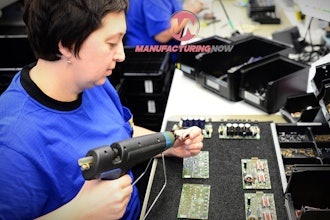FOCUS ON SOFTWARE?
Today's international firms and U.S. firms that manufacture or sell products overseas require global trade management (GTM) solutions to manage the complex business processes associated with cross-border global trade. GTM systems help streamline end-to-end import and export processes, speed global supply chains, and ensure trade compliance.
Numerous vendors offer diverse products with varying business models. What are the essential features a GTM system must possess in order to meet most companies' global trade needs? In this report, Wayne Slossberg, vice president QuestaWeb Inc., a provider of Web-based global trade and logistics management solutions, presents his list of 11 critical features.
Every company has specific business processes. A GTM system should be configurable to accommodate these unique practices with minimal customization. The system should provide end-to-end visibility, and its internal procedures should ensure efficiency and precision. Look for built-in reporting tools and query functionality.
The GTM system must perform import and export procedures in accordance with U.S. Customs rules and regulations. All codes (Harmonized Tariff Schedule, Export Control Classification Number, etc.) should be resident within the GTM system, and the system should possess a reliable means for maintaining ever-changing vendor and product information. In particular, the ability to manage this information simultaneously when the same product is being made in several different countries concurrently is imperative. Via GTM, all participants in a supply chain should be linked, providing a trail of a product's logistical path from sales order entry or purchase order to end-user, whether going to a distribution center or a direct ship to client. The GTM must perform security checks and have the processes in place to comply with 10+2 provisions.
The GTM system should calculate accurate landed costs. Thus, it must contain all tariff, duty, harbor fees, transportation fees, etc. for anywhere in the world. The capability to perform comparative analyses of logistic costs utilizing "what if" scenarios is vital. Moreover, the GTM system should possess the functionality to monitor all supply chain participants' estimated charges and invoicing so that comparisons of final costs against estimated or anticipated costs are possible. This enables substitution of more cost-effective alternatives. The GTM system also should have the capacity to apply all logistic costs to products as well as to countries that have special programs or preferential treatments. Where quotas apply, the system should be able to monitor quota levels so that sourcing decisions can be made efficiently, and costs can be adjusted and calculated in real-time. Landed cost comes into play during product development, and it is an effective planning tool in the beginning stages of costing products.
Information is the heart and soul of the GTM system. Centralizing information is imperative for compliance as well as for system integrity. Today, Oracle and SQL servers are the usual choice in database technology; thus, the GTM system should be compatible with them. The ability to store all information in one place is key, as is the ability to share it. Because compliance integrity is critical, the GTM system must be able to attach binding rulings and Anti-Dumping Duty/ Countervailing Duty (ADD/CVD) cases to products, along with product specifications and bills of material. Query capability and reporting on database information are paramount.
Data input, regardless of process, should occur only once, and data should be maintained universally. These features yield better information flow, minimize errors, and prevent redundant information. One-time data entry, coupled with a central database, makes processes such as drawback and reconciliation more productive and efficient.
Web-based technology is the future. It not only allows everyone in the supply chain to participate at little or no cost but also promotes visibility during the import/export process. Any GTM system that is not Web-based should be suspect regarding its future technological viability.
ERP (enterprise resource planning), PLM (product lifecycle management), WMS (warehouse management systems), and SCM (supply chain management) systems are present in virtually every company. They contain vital information that should be shared with the GTM system. In years past, integration was painful, costly, and time consuming. Today, these challenges are virtually eliminated by the best vendors, which should be able to demonstrate efficient methods for integration. Look for firms that offer integration modules that enable in-house IT staff to do most of the integration. This can be a huge cost-savings measure.
Managing trade is a time-consuming and time-sensitive process. Information flow must be compliant as well as consistent. The process can and does become complex. Automation is a must. The GTM system must automatically populate and generate required documentation and communicate to all parties in the trade process. Automation promotes cost savings by controlling head count in the import/export compliance department. Better still, it allows users to manage the multi-step process by exception instead of desperation. That is, the GTM system must have the built-in logic to handle most situations and only bring items outside this logic to staff attention.
All GTM solutions produce documentation. However, the system must produce the right document for the right product and for the right country along with the required filings (FDA, Fish and Wildlife Service, DOT, etc.). All documentation must be consistent, compliant, and accurate. Documentation requirements change frequently, so it is important to understand the process utilized by the GTM solution to monitor and adjust for changes in documentation and filings.
ABI (automated broker interface) is a virtual private network (VPN) for communicating with U.S. Customs. It is the method used by many importers to clear shipments through Customs and for exporters to file via the automated export system (AES) to move products out of the U.S. It is not a necessity to have this functionality in a GTM system, but it is a real plus because of the options it affords. With it, real-time updates from Customs on changing tariffs and regulations yield real-time updates to the GTM system. Self-entry is possible as well as communication with brokers and freight forwarders.
Global trade requirements result in the generation of massive numbers of documents. Customs regularly requests firms to produce these documents in the case of inspections and focused assessments. A GTM system with a document binder maintains all the documents in one place in an orderly fashion. This eliminates the nightmare and cost of contacting manufacturers, brokers, importers, exporters, freight forwarders, and so on to obtain copies.
More information is available by contacting QuestaWeb Inc., Westfield, NJ, at 908-233-2300 or www.questaweb.com.ITH CIquestaweb_report?It allows users to manage the multi-step process by exception instead of desperation'
Today's international firms and U.S. firms that manufacture or sell products overseas require global trade management (GTM) solutions to manage the complex business processes associated with cross-border global trade. GTM systems help streamline end-to-end import and export processes, speed global supply chains, and ensure trade compliance.
Numerous vendors offer diverse products with varying business models. What are the essential features a GTM system must possess in order to meet most companies' global trade needs? In this report, Wayne Slossberg, vice president QuestaWeb Inc., a provider of Web-based global trade and logistics management solutions, presents his list of 11 critical features.
1. Configurability
Every company has specific business processes. A GTM system should be configurable to accommodate these unique practices with minimal customization. The system should provide end-to-end visibility, and its internal procedures should ensure efficiency and precision. Look for built-in reporting tools and query functionality.
2. Automated Compliance Functionality
The GTM system must perform import and export procedures in accordance with U.S. Customs rules and regulations. All codes (Harmonized Tariff Schedule, Export Control Classification Number, etc.) should be resident within the GTM system, and the system should possess a reliable means for maintaining ever-changing vendor and product information. In particular, the ability to manage this information simultaneously when the same product is being made in several different countries concurrently is imperative. Via GTM, all participants in a supply chain should be linked, providing a trail of a product's logistical path from sales order entry or purchase order to end-user, whether going to a distribution center or a direct ship to client. The GTM must perform security checks and have the processes in place to comply with 10+2 provisions.
3. Landed Cost Calculation
The GTM system should calculate accurate landed costs. Thus, it must contain all tariff, duty, harbor fees, transportation fees, etc. for anywhere in the world. The capability to perform comparative analyses of logistic costs utilizing "what if" scenarios is vital. Moreover, the GTM system should possess the functionality to monitor all supply chain participants' estimated charges and invoicing so that comparisons of final costs against estimated or anticipated costs are possible. This enables substitution of more cost-effective alternatives. The GTM system also should have the capacity to apply all logistic costs to products as well as to countries that have special programs or preferential treatments. Where quotas apply, the system should be able to monitor quota levels so that sourcing decisions can be made efficiently, and costs can be adjusted and calculated in real-time. Landed cost comes into play during product development, and it is an effective planning tool in the beginning stages of costing products.
4. Centralized Database
Information is the heart and soul of the GTM system. Centralizing information is imperative for compliance as well as for system integrity. Today, Oracle and SQL servers are the usual choice in database technology; thus, the GTM system should be compatible with them. The ability to store all information in one place is key, as is the ability to share it. Because compliance integrity is critical, the GTM system must be able to attach binding rulings and Anti-Dumping Duty/ Countervailing Duty (ADD/CVD) cases to products, along with product specifications and bills of material. Query capability and reporting on database information are paramount.
5. One-Time Data Entry
Data input, regardless of process, should occur only once, and data should be maintained universally. These features yield better information flow, minimize errors, and prevent redundant information. One-time data entry, coupled with a central database, makes processes such as drawback and reconciliation more productive and efficient.
6. Web-Based Technology
Web-based technology is the future. It not only allows everyone in the supply chain to participate at little or no cost but also promotes visibility during the import/export process. Any GTM system that is not Web-based should be suspect regarding its future technological viability.
7. Integration
ERP (enterprise resource planning), PLM (product lifecycle management), WMS (warehouse management systems), and SCM (supply chain management) systems are present in virtually every company. They contain vital information that should be shared with the GTM system. In years past, integration was painful, costly, and time consuming. Today, these challenges are virtually eliminated by the best vendors, which should be able to demonstrate efficient methods for integration. Look for firms that offer integration modules that enable in-house IT staff to do most of the integration. This can be a huge cost-savings measure.
8. Automation
Managing trade is a time-consuming and time-sensitive process. Information flow must be compliant as well as consistent. The process can and does become complex. Automation is a must. The GTM system must automatically populate and generate required documentation and communicate to all parties in the trade process. Automation promotes cost savings by controlling head count in the import/export compliance department. Better still, it allows users to manage the multi-step process by exception instead of desperation. That is, the GTM system must have the built-in logic to handle most situations and only bring items outside this logic to staff attention.
9. Compliant Documentation
All GTM solutions produce documentation. However, the system must produce the right document for the right product and for the right country along with the required filings (FDA, Fish and Wildlife Service, DOT, etc.). All documentation must be consistent, compliant, and accurate. Documentation requirements change frequently, so it is important to understand the process utilized by the GTM solution to monitor and adjust for changes in documentation and filings.
10. ABI Connection
ABI (automated broker interface) is a virtual private network (VPN) for communicating with U.S. Customs. It is the method used by many importers to clear shipments through Customs and for exporters to file via the automated export system (AES) to move products out of the U.S. It is not a necessity to have this functionality in a GTM system, but it is a real plus because of the options it affords. With it, real-time updates from Customs on changing tariffs and regulations yield real-time updates to the GTM system. Self-entry is possible as well as communication with brokers and freight forwarders.
11. Document Binder
Global trade requirements result in the generation of massive numbers of documents. Customs regularly requests firms to produce these documents in the case of inspections and focused assessments. A GTM system with a document binder maintains all the documents in one place in an orderly fashion. This eliminates the nightmare
More information is available by contacting QuestaWeb Inc., Westfield, NJ, at 908-233-2300 or www.questaweb.com.ITH CIquestaweb_report?It allows users to manage the multi-step process by exception instead of desperation'


















